Look, I’ll be honest: I’m bullish on our favorite income investments, high-yield closed-end funds (CEFs), as we head toward 2024.
Fact is, these overlooked income stalwarts are still on sale after the 2022 pullback, with the ticker we’ll talk about below going for an absurd 17.2% below its true value.
We can thank CEF investors’ conservative nature for that—they still don’t trust this year’s rebound. So our chance to grab big payouts at a discount is still available. Right now, the portfolio of my CEF Insider service is generating a rich 9.9% average yield.
But that said, we always need to keep an eye on factors that could go sideways in the future, so we can shift gears—and protect our capital and income streams—at a moment’s notice.
As I’ve looked at the markets over the last decade, the biggest risks have changed a lot. Heck, they’ve changed a lot since the banking mini-crisis last March. Let’s get into the main ones now, and put them in perspective so we can build our income portfolios with confidence.
Risk #1: US Bankruptcies Rise
High interest rates are a risk for the economy because they make debt pricier—in turn making it tougher for highly indebted people and businesses to pay the bills.
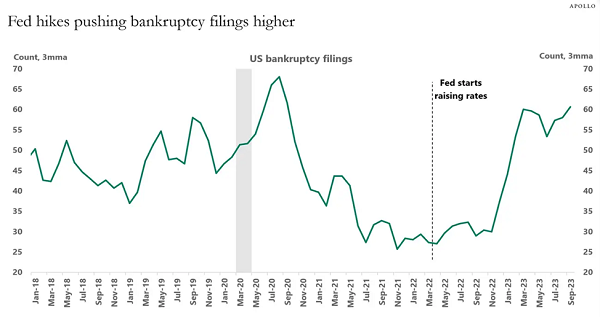 Source: Apollo Global Management
Source: Apollo Global Management
That’s Business 101, and to be sure, that post-2022 line in the chart above does look worrying. But with this and all statistics, context is everything. Already, this chart shows bankruptcies are only a bit higher than they were in 2019, not a bad year economically speaking. And when we zoom out further, things look better still.
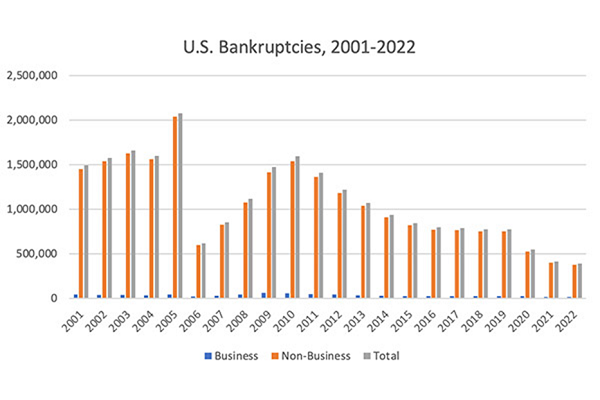 Source: U.S. Courts, Debt.org
Source: U.S. Courts, Debt.org
Bankruptcy rates have been falling for a long time, and until we see them triple from today’s levels, we’re nowhere near where we were in the bubble years of the early 2000s.
To be honest, I think that is likely to happen, but it’s going to take years, maybe a decade. If this keeps you on the sidelines, you could miss out on considerable gains: just in the last 10 years, for example, the S&P 500 rose a little over 200%.
There’s a saying in finance: sometimes being early is the same as being wrong. Situations like this are why that statement rings true.
Risk #2: Inflation Makes a Comeback
The biggest risk, at least in the eyes of readers of my columns on Contrarian Outlook and my CEF Insider service, seems to be inflation.
And inflation is the most visible economic phenomenon: everyone notices when prices go up, most notably on the big signs at gas stations. (Funny thing is, even though these are quite literally the poster children for inflation, Americans only spend 2.24% of their income on gas on average, according to J.D. Power data.) But jumps in prices for things like gas may prompt Americans to spend less overall. That hasn’t happened yet (see point #3 below), but it’s a risk. So how big is this concern now?
Inflation Is Fading
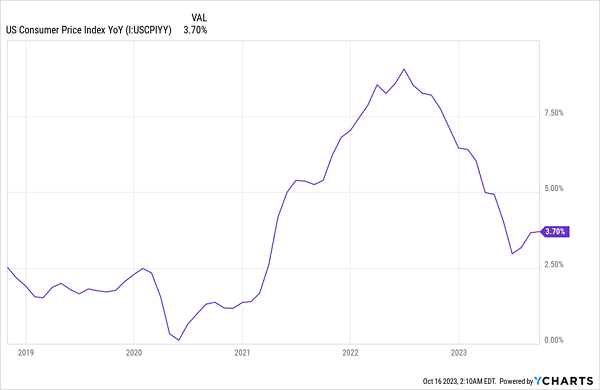 Over the long term, inflation is weakening. Last month’s jump from 3.2% to 3.7% is a little worrying, but it’s too early to say this is a significant risk. So while we can say the inflation risk has risen very slightly, the key thing we need to dig into is whether this is stopping Americans from spending.
Over the long term, inflation is weakening. Last month’s jump from 3.2% to 3.7% is a little worrying, but it’s too early to say this is a significant risk. So while we can say the inflation risk has risen very slightly, the key thing we need to dig into is whether this is stopping Americans from spending.
Risk #3: Americans Stop Spending
Firstly, the answer to that is no.
Spending Growth Accelerates
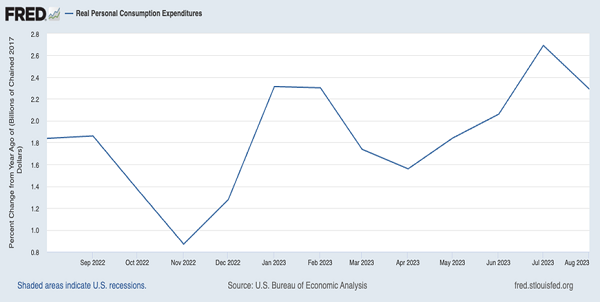 In 2023, Americans have trended towards spending more year over year, even after accounting for inflation. There’s a bigger worry for the long term, though: that the growth in Americans’ wealth will slow or stop altogether.
In 2023, Americans have trended towards spending more year over year, even after accounting for inflation. There’s a bigger worry for the long term, though: that the growth in Americans’ wealth will slow or stop altogether.
This is a perennial concern, which paradoxically is why it’s not something we don’t need to worry much about: while leaders in places like Thailand or Russia might not care if their citizens get richer, the corporate world cares a lot about Americans getting richer because it depends on them to buy its products. Besides, this chart of the very long term shows this isn’t a concern.
Americans’ Wealth Continuously Grows
 Here we see the amount of discretionary spending power of each American individual after accounting for inflation. It’s been up and to the right for decades.
Here we see the amount of discretionary spending power of each American individual after accounting for inflation. It’s been up and to the right for decades.
We’ve seen real disposable personal income rise 7.7% over the last five years, which is much greater than the 1.8% average rise over the last 30 years and the 2.1% gain we’ve seen since this data was first collected in 1959.
At a fundamental level, Americans are getting richer. And they’re spending more.
Americans Keep Spending More
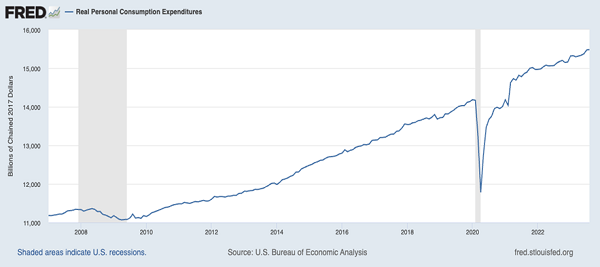 After inflation, people over the last five years have been spending 2.4% per year more on average, again more than the 2% growth we’ve seen on average since this data was first collected in 2007. (Bear in mind that these figures are averages taken across the entire US population.)
After inflation, people over the last five years have been spending 2.4% per year more on average, again more than the 2% growth we’ve seen on average since this data was first collected in 2007. (Bear in mind that these figures are averages taken across the entire US population.)
Economic Fears Set the Table for This 10% Payer
For us income investors, the best move in this environment is to buy a CEF like the General American Investors Fund (GAM). Over 90 years of age, it’s one of the oldest CEFs out there and holds some of the most established companies, including waste manager Republic Services (RSG), Microsoft (MSFT), Apple (AAPL) and Berkshire Hathaway (BRK).
GAM’s net asset value (NAV, or its underlying portfolio) has also had a strong year, nudging ahead of the S&P 500. And thanks to that 17.2% discount to NAV, we can essentially buy the fund’s portfolio at late-2022 prices (these discounts are yet another edge we CEF investors love).
GAM Books a Strong Gain—and We Can Still Buy Cheap
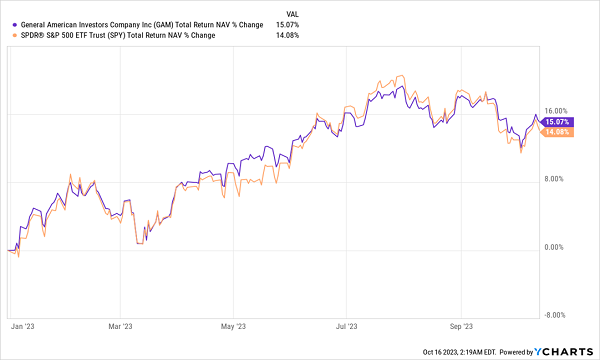 Those gains are why GAM will likely pay a big special dividend this year, which it typically announces in early November (GAM pays out most of its dividend as a one-time year-end payout made up of income and gains on its portfolio). I’m expecting an overall 10% annualized yield from this one payout alone, which would be a big jump from last year’s sub-5% yield.
Those gains are why GAM will likely pay a big special dividend this year, which it typically announces in early November (GAM pays out most of its dividend as a one-time year-end payout made up of income and gains on its portfolio). I’m expecting an overall 10% annualized yield from this one payout alone, which would be a big jump from last year’s sub-5% yield.
— Michael Foster
It’s Not Just GAM—Our Buy Window on These 4 BIG Dividends Is Open, Too [sponsor]
When it comes to CEFs, we ALWAYS demand big discounts and big dividends. And I’ve got 4 other CEFs I’m pounding the table on now, with dividends and discounts that will be shiny lures to income seekers as rates top out this year and “roll over” in 2024.
These 4 funds are all top CEF Insider picks, and the time to buy them—and start enjoying their Treasury-crushing income streams—is now.
This quartet yields 9.5% between them and sport discounts so deep I see them primed for 20% price gains in the next 12 months.
I’m ready to share the details on all four of them with you now. Click here to learn more and get an opportunity to download a free Special Report naming all 4 of these cash-spinning funds, including their names, tickers, discounts and current yields.
Source: Contrarian Outlook
